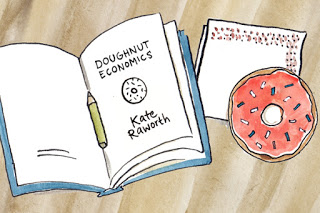Summary:
Many of us know we need to rethink economics, but Kate Raworth actually did it. Envisioning the economy as a doughnut, two boundaries become clear. If we fall into the doughnut’s middle hole, human needs fail to be met. If we drop off of the outer edge, life is unsustainable. You should be weary of people who seek to get the “first lick” on a young impressionable brain. Paul Samuelson knew that by writing a successful economics textbook, he could influence how students frame the economy, and thus the world. From the 50’s to the 70’s, his textbook was the most widely used in introductory economics courses. Today, that role has been given to Gregory Mankiw’s “Macroeconomics” (see the Open Syllabus Project). Both view the economy in the same narrow way, with the same simple pictures that
Topics:
Mike Norman considers the following as important:
This could be interesting, too:
Many of us know we need to rethink economics, but Kate Raworth actually did it. Envisioning the economy as a doughnut, two boundaries become clear. If we fall into the doughnut’s middle hole, human needs fail to be met. If we drop off of the outer edge, life is unsustainable. You should be weary of people who seek to get the “first lick” on a young impressionable brain. Paul Samuelson knew that by writing a successful economics textbook, he could influence how students frame the economy, and thus the world. From the 50’s to the 70’s, his textbook was the most widely used in introductory economics courses. Today, that role has been given to Gregory Mankiw’s “Macroeconomics” (see the Open Syllabus Project). Both view the economy in the same narrow way, with the same simple pictures that
Topics:
Mike Norman considers the following as important:
This could be interesting, too:
Robert Vienneau writes Austrian Capital Theory And Triple-Switching In The Corn-Tractor Model
Mike Norman writes The Accursed Tariffs — NeilW
Mike Norman writes IRS has agreed to share migrants’ tax information with ICE
Mike Norman writes Trump’s “Liberation Day”: Another PR Gag, or Global Reorientation Turning Point? — Simplicius
Many of us know we need to rethink economics, but Kate Raworth actually did it. Envisioning the economy as a doughnut, two boundaries become clear. If we fall into the doughnut’s middle hole, human needs fail to be met. If we drop off of the outer edge, life is unsustainable.
You should be weary of people who seek to get the “first lick” on a young impressionable brain. Paul Samuelson knew that by writing a successful economics textbook, he could influence how students frame the economy, and thus the world. From the 50’s to the 70’s, his textbook was the most widely used in introductory economics courses. Today, that role has been given to Gregory Mankiw’s “Macroeconomics” (see the Open Syllabus Project). Both view the economy in the same narrow way, with the same simple pictures that don’t seem useful today. Raworth’s Doughnut Economics breaches the pattern and envisions a new economics, for a new generation with clearly defined challenges and scant tools to solve them.
For so many years, the principle goal of economics, and thus the economy, has been GDP growth. Growth for whom or through what means wasn’t nearly as important as just ensuring there was in fact growth. Raworth emphasizes the importance of framing, and if you ask an economist what picture they foresee for GDP, they often describe an upward exponential function.
Thankfully, many young students that I’ve met recognize that infinite growth is unsustainable. Hopefully, their generation can popularize a GDP graph in the shape of a sideways S, respecting the upper bound to growth we have to live within. Enter Raworth’s doughnut. In Raworth’s framework, the outside of the doughnut reflects an upper bound we can not pass based on environmental limits of our planet. The inside of the doughnut reflects a social foundation we can not let crack, the necessities for humanity to thrive.

